When you run, you land at approx. 3 times your own body weight on your foot. The shock goes up through your foot and leg. In this Practical running shoe guide for runners of all levels, we explain the importance of choosing the right running shoes for your feet to suit your running style, so you can choose the best pair for your running surface and the distances you choose to run. There are a lot of running shoes to choose from in Sports shops and online.
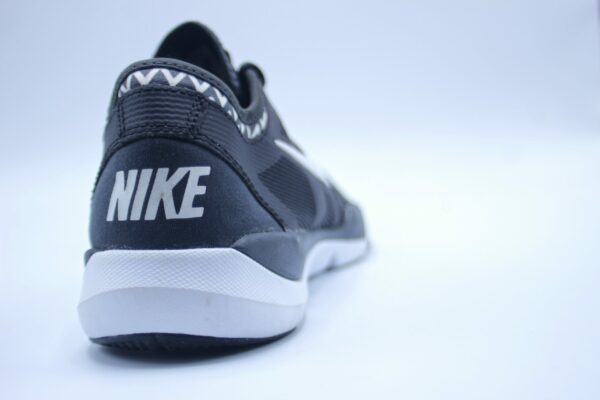
So how would you rate which running shoes you should choose? It is always a good idea to get a thorough running analysis in a specialty store before investing in running shoes. This can be done by trying on different running shoes on a treadmill while the shop assistant films your feet and assesses your running style.
Why Running Analysis Is Important?
A running analysis is important because it can help reduce the body’s compensation when we run. Imbalances around the joints mean that the large muscle groups such as the hamstrings, glutes and quads often do less of the work they are built for. Instead, less stabilizing muscles go in and compensate.
These ‘less suitable’ stabilizers are forced to compensate kilometer after kilometer when you run, and this can lead to long-term injuries that affect your ability to train consistently. Therefore, if you take your running seriously, the questions that a running analysis can reveal are invaluable. You will also get answers to what kind of support the shoes should have and thus improve your running efficiency.
Important to know is, that there is very advanced equipment out there today, that very precisely measures how you move when you run. The older of us maybe don’t think of this opportunity!
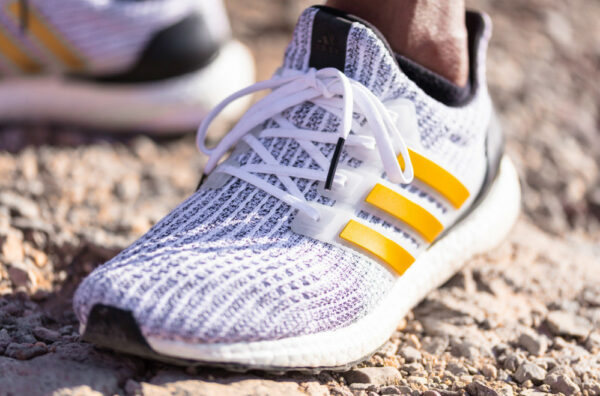
You can visit Asics free gait analysis or Qualisys to find more info about this purpose. You can also choose a ‘homemade’ but a very effective method by examining some of your old shoes’ soles and looking at the wear pattern – or even take them with you to the sports store and show them to the salesperson. Once you know what type of runner you are, you can go to the next step in looking at the selection of running shoes that suits your running style…
The Best Running Shoes
When it comes to finding the best running shoes for your running style, we often ask ourselves: Which running shoes should I buy?
In tests and selection of running shoes, we should mainly assess characteristics such as:
- Cushioning and stability: How well-cushioned are the running shoes? How do they perform on different kinds of surfaces? Are they stable? What kind of race are they best suited for?
- Comfort and fit: How is the size – small, medium or large? How does the shoe sit on the foot? How is the inside of the shoe – are there seams that can gnaw? Is the shoe wide or narrow in fit? Is the shoe light or does it weigh more? How do your feet feel after the run? How do the shoes feel to run with? Do the shoes give off extra energy in the heel?
- Special features such as lightweight and shock absorption give a little extra momentum and a higher tempo or extra wide, good fit and smart, simple design – the ‘extra’ quality that stands out with the individual running shoes. This is also a more personal assessment of your preferences.

Choose the right running shoe
So, finding running shoes is personal. No matter what anyone tells you, there is no one best pair of running shoes for all people. What you can do as a first step would be to take off your socks and stand up with balance on both feet, and assess your own foot position – you can maybe get another person to assess the foot in a standing position:
- If you have a low arch (flat foot), you should usually choose a running shoe that is easy to strong overpronation.
- If you have a normal arch, choose an easy overpronation running shoe or a neutral running shoe
- If you have a high arch, you should as start point choose a neutral running shoe
- Check if you are wheel-legged, i.e., if your knees are pointing outwards. This often means that you are a neutral or supination runner and must therefore choose a neutral or supination running shoe
- Check if you have ‘calf kneed’, i.e., if your knees point towards each other when you get up. This often means that you are at risk of falling inwards on your feet in the standing phase and thus have to look for a running shoe with light to strong overpronation.
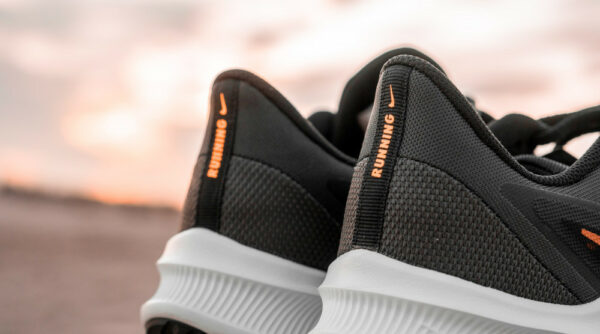
What you need to know about running shoe size selection
Another question you may have asked yourself before is: “what size of running shoes?”. Finding the right size of running shoes can be difficult. This is primarily because the different brands do not use the same terminology. You probably know the same problem with normal shoes – what size? Aspects that can impact the right running shoe size are:
- The foot arch can be lowered over time, resulting in a longer foot, or a stronger foot can cause the arch to become higher, resulting in a shorter size.
- Weight changes and activity levels can also affect foot size. Weight gain during e.g., Pregnancy can cause a permanent lowering of the foot arch, resulting in a longer foot.
- A tighter fit means you stay better connected with the shoes as you increase the pace, so it may be worth giving up a little ‘space in the box’ for a more secure fit.
- Many racing and performance shoes have a tighter overall fit than everyday training shoes.
- You can change the thickness of your sock to fine-tune your fit. For example, use a thinner sock to create more space or a thicker sock to make the fit better.
What is the best running shoe
It’s up to you to find the best shoe, but a good solution in general is to choose a half to one size larger than your normal shoes. If you normally use a size 38 in shoes, you must use approximately size 38½ or 39 in running shoes, but this also varies from brand to brand.
Some brands use UK sizes in particular, making the size choice even more complicated. But whether you know your size in centimeters, UK, US or EUR makes no difference as long as you can convert the size measurements.
Because for some reason the running shoe manufacturers do not completely agree on how big a running shoe in size EUR 39 or size EUR 45 is. If you already have a running shoe, it means that you cannot automatically assume that you must have the same size if you change to another brand!
The various size measures used today worldwide are often CM, UK, US, EUR. For example, if you use size 45 in Nike, you must have size 46 in Asics! Therefore, it is appropriate to have a size guide for running shoes that summarizes the different sizes across units of measurement as you will see in the tables below.
It is also important to emphasize that we all have unique feet. Some have wide feet while others have narrow feet. It varies a bit with the sizes.
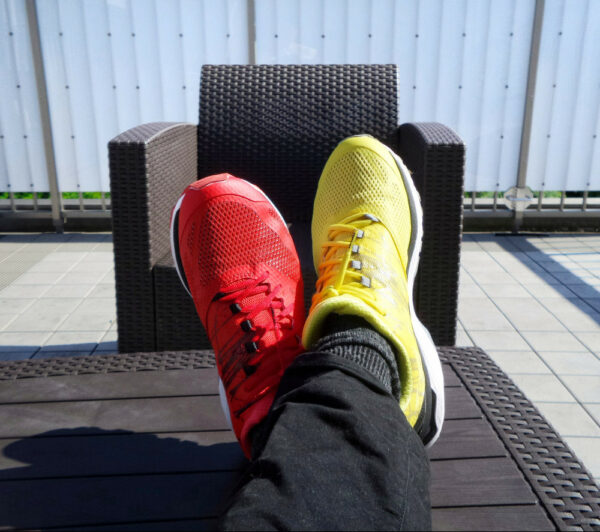
How to find the right size for running shoes
As you see, the sizes from brand to brand are different, it can often be difficult especially when we have to choose and buy new running shoes from the web. For example, if I have found a running shoe online of a different brand than I have had before, it can be a challenge to find the right size as I have no basis for comparison? Therefore, it might be a good idea if there was a blueprint for the different shoe sizes.
There are generally two ways to find the right shoe size:
1. You already have a pair of running shoes that fit you great.
2. You do not have a pair of running shoes already.
I already have a pair of running shoes
If you already have a pair of running shoes that fit you great, you can do this:
Use one of the tables at the bottom of this post – Table 1 Men’s running shoe size or Table 2 Women’s running shoe size:
1. Find the brand and size of your current running shoes in the table
2. Go vertically up or down until you come next to the brand that your upcoming running shoe has
3. You can now see which size you should buy
If you do not have a pair of running shoes already:
CM size indicates the inside length of the shoe in centimeters and is the best basis for comparison when you need to buy a new shoe, as it is the only size statement that is consistent across brands. If you do not have a running shoe in advance, you can find the right size by measuring the length of your foot and choose from the CM indication row of the shoes in the table.
If you do not find the brand of your current running shoes in the tables below, you can start from the CM indication that is inside your running shoes. You need to look for the number that is below “CM” or “JP” inside your running shoes. Then you can find the correct size of the shoe, that you would like to buy by looking in the column with the CM size that is in your shoe – see image here:

Running Shoe Size Guide
The tables below are as mentioned based on the running shoe’s CM indication, which indicates the shoes inside length in centimeters, as the best basis for comparison when you need to buy a new running shoe.
The tables provide the correct size in the vast majority of cases. However, there is sometimes a risk that a shoe deviates a bit from these tables if, for example, they have a very close-fitting upper or the like that may make it necessary to go half a cm up in size.
The Best Running Shoes Men
On this point, you have good knowledge about running shoes. For most of us, finding the best running shoes for our needs is a challenge. There are hundreds of great running shoes to choose from, and going through them all is an almost never-ending process.
So, to find the best running shoes, it’ll be a good starting point to look at the biggest running brands on the market. In this way, we already know that running shoes from these brands have been researched, thoroughly tested, and described in hundreds of models and evaluated on how well they live up to their intended purpose: to provide a comfortable running experience.
Below are two shoe size tables of the best running shoe brands in the world. After choosing a brand and a size, you can start being more specific on your shoe choice according to your purpose with running – trail running, long distance, sprint, etc.
Table 1 Men
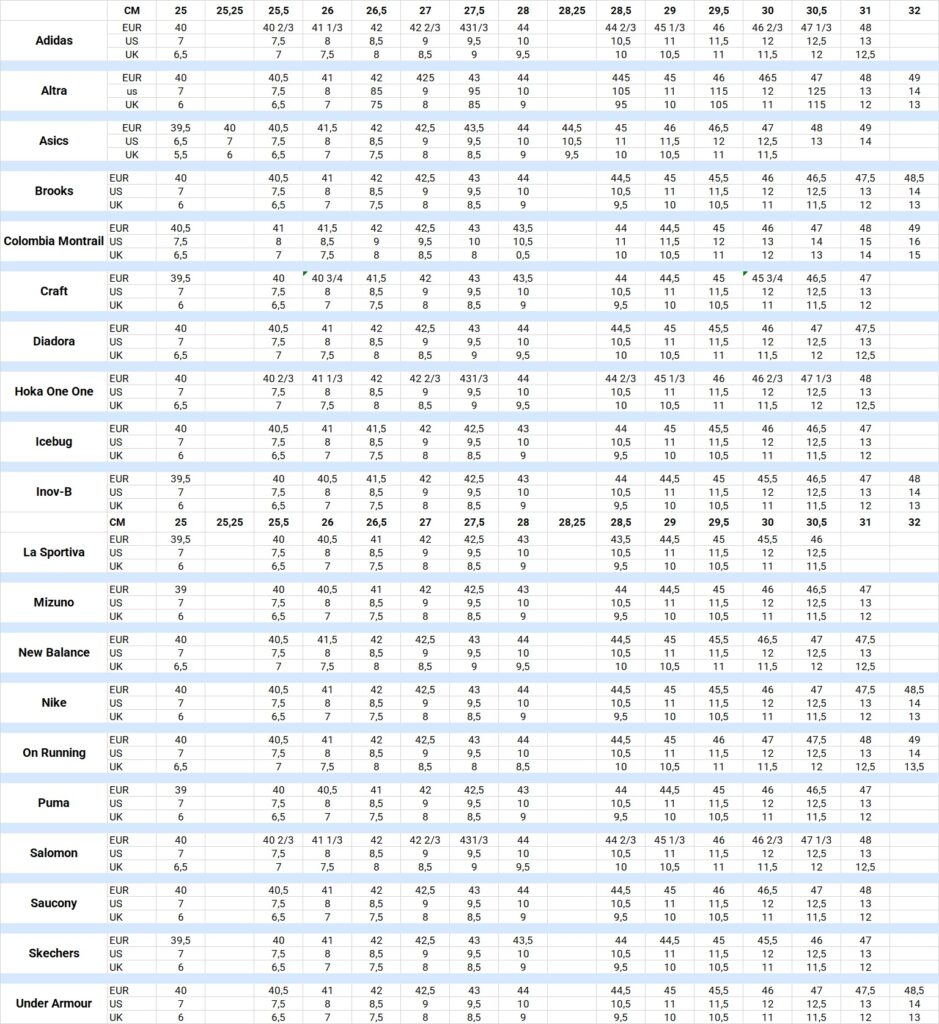
The Best Running Shoes Women
There is often a difference between the colors of men’s and women’s running shoes, and in addition, men’s running shoes are often available in larger sizes. But if you’ve found a color you like and the size is right too – So in principle, there’s no problem here!
But there are several details that distinguish women’s shoes from men’s shoes – the biggest of them is the fit. Women’s running shoes are generally narrower than men’s running shoes – specifically, they are narrower at the heel and wider at the forefoot, as women often have problems with a crooked big toe that needs extra space.
This can therefore contribute to women feeling that there is too much space in men’s running shoes, and men, on the contrary, feeling that women’s running shoes are too tight.
Women are also generally lighter than men in terms of weight. So, when we run, many of us need cushioning to make each step less stressful on the legs. In men’s running shoes, the cushioning is therefore higher because men generally need it more due to their higher weight.
Table 2 Women

Final Thoughts
There is a huge selection of running shoes on the market today. Choosing the right one for you means that you should focus on how to get the most out of your chosen running shoes.
By starting with running style and ending with shoe size across brands, you will have a good starting point, which is the purpose of this post. There is a lot you can do yourself that you might not have thought of and a lot you can get researched and done by other specialists.
I hope you like this post, and if you have any questions about Practical running shoe guide for runners at all levels, or want to leave your own Personal review, please leave a comment below.
[faq-schema id=”4645″]

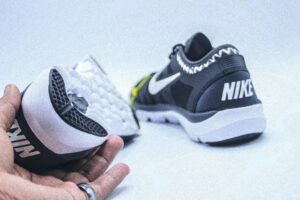




Thank you for this article! Every 6 months I am tryin to find some shoes that fit and feel GOOD and every time, I end up chucking them into the bin before I can even get a good wear out of them.. I am definitely going to check to see if there is a shop here to help me identify my running style and get fitted properly before i start my running journey. Super informative article thank you!
Hi Rachel
Thank you for the comment. Finding your running style first is the best thing you can do for your running journey – wish you the best here
I learnt a hard lesson when it comes to selecting running shoes. I selected the wrong pair for my body type and it lead to painful legs overtime. Took a long time to recover and I had to visit a feet expert to solve my problems. The analysis you mentioned, how does it work? Is it in a store or can I get it on a app for my phone?
Hi Bernard
Thank you for the comment and your question.
A running gait Analysis is a professional health tool used to locate a cause of your pain / injuries in relation to running – in a clinic. At the same time, the analysis is a tool to improve and develop the committed runner. You can learn more here: https://bit.ly/3omWroI
Be Well
Thank you for sharing these points. I began running in March 2020, when the pandemic started. And after that, I have increased my training to swimming and doing a bit of gym. But my main goal is running.
I had not considered searching for a blueprint before buying our running shoes. But due to how important a good fit is, this suggestion is gold.
Is this table about the CM indication official? I mean, how did it come into existence? Did every brand give its measurements? Or is it created by a third party?